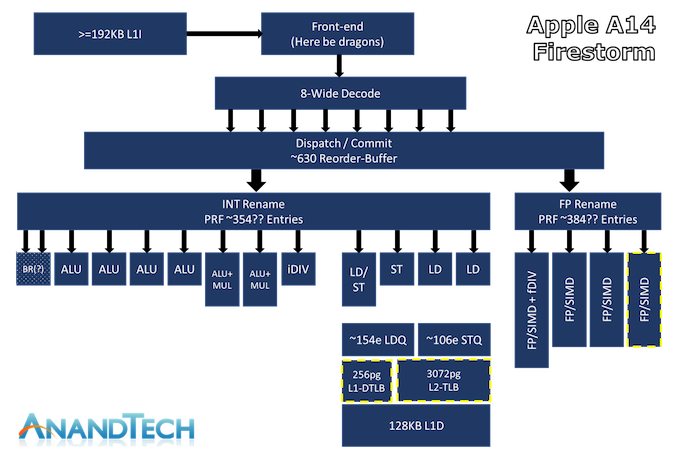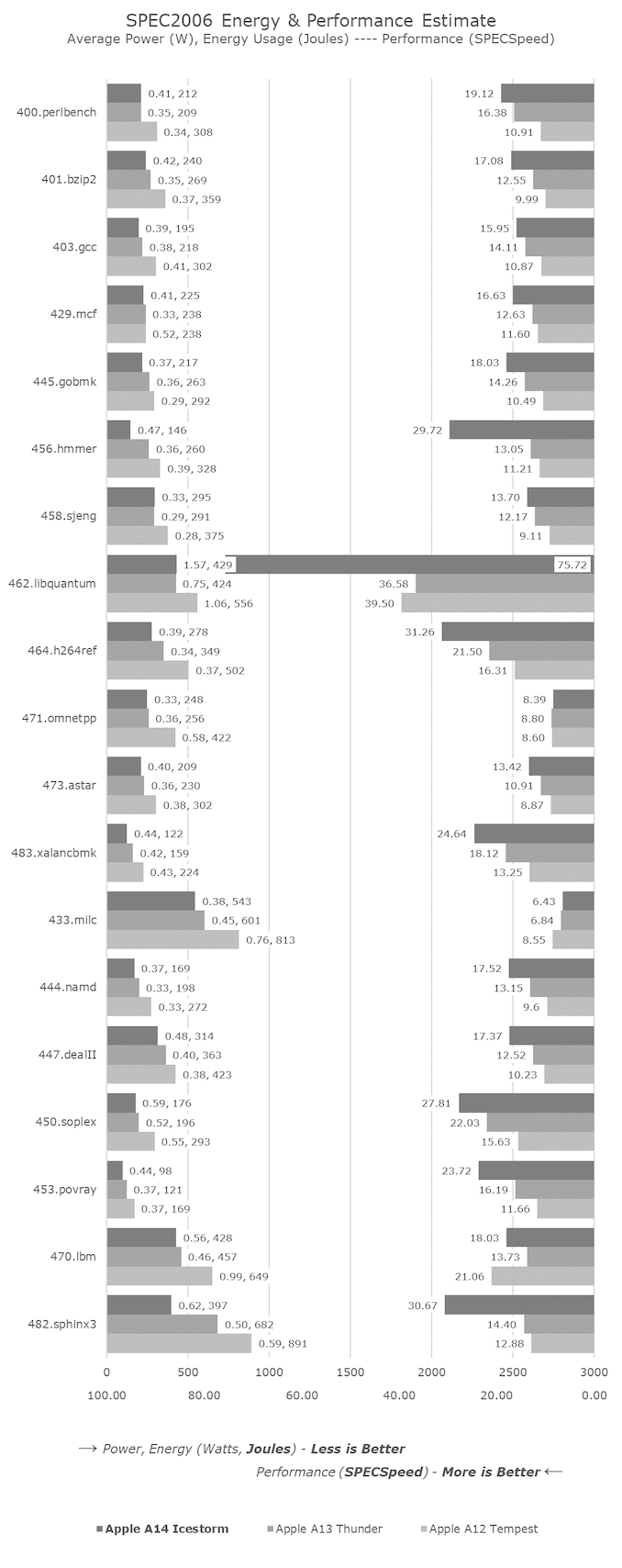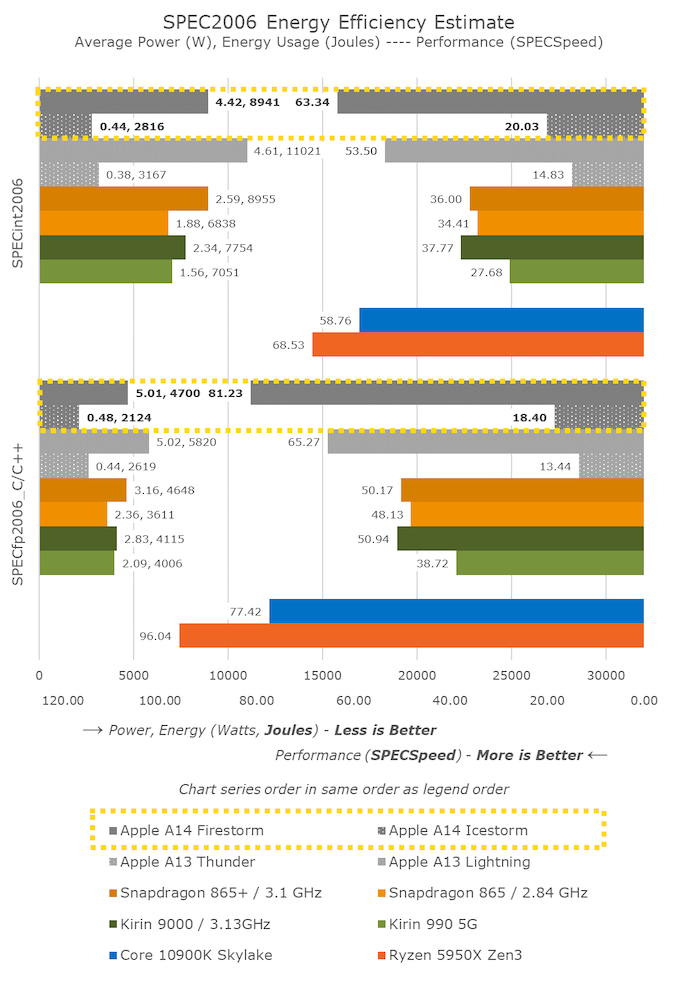The iPhone 12 & 12 Pro Review: New Design and Diminishing Returns
by Andrei Frumusanu on November 30, 2020 8:30 AM EST- Posted in
- Mobile
- Apple
- Smartphones
- Apple A14
- iPhone 12
- iPhone 12 Pro
The Apple A14 SoC: Firestorm & Icestorm
The new Apple A14 is the company’s newest mobile SoC and sits at the heart of the new iPhone 12 series. The new chip is the industry’s first commercial 5nm manufactured chip from TSMC, alongside the now no longer manufactured Kirin 9000.
Inside the A14 we find two big performance cores dubbed “Firestorm” and four efficiency cores called “Icestorm”, making this a 2+4 heterogeneous CPU SoC. Alongside the CPUs, we also find a 4-core GPU. Unfortunately this year it seems like we haven’t seen a public die shot of the A14, though Apple themselves published a shot of the M1 during their announcement event.
| Maximum Frequency vs Loaded Threads Per-Core Maximum MHz |
||||||
| Apple A13 | 1 | 2 | 3 | 4 | 5 | 6 |
| Performance 1 | 2666 | 2590 | 2590 | 2590 | 2590 | 2590 |
| Performance 2 | 2590 | 2590 | 2590 | 2590 | 2590 | |
| Efficiency 1 | 1728 | 1728 | 1728 | 1728 | ||
| Efficiency 2 | 1728 | 1728 | 1728 | |||
| Efficiency 3 | 1728 | 1728 | ||||
| Efficiency 4 | 1728 | |||||
| Apple A14 | 1 | 2 | 3 | 4 | 5 | 6 |
| Performance 1 | 2998 | 2890 | 2890 | 2890 | 2890 | 2890 |
| Performance 2 | 2890 | 2890 | 2890 | 2890 | 2890 | |
| Efficiency 1 | 1823 | 1823 | 1823 | 1823 | ||
| Efficiency 2 | 1823 | 1823 | 1823 | |||
| Efficiency 3 | 1823 | 1823 | ||||
| Efficiency 4 | 1823 | |||||
The new A14 raises the clock speeds of the CPU by a good amount, now essentially reaching 3GHz on the large performance cores in single-threaded scenarios. Once a second big cores come on this reduces to 2.89GHz and stays there even in heavier multi-threaded workloads. The efficiency cores land in at 1823MHz now, roughly a 100MHz boost over the A13, but we do know that in power unconstrained scenarios they can reach quite higher, such as 2064MHz employed on the M1.
The summary is that in this generation, Apple progresses the design further and making it wider than before, increasing the ROB size from 560 to 630, having significantly larger L1 DTLB which has now doubled in size from 128 pages to 256 pages, and increasing the L2 TLB from 2048 pages to 3072 pages. It’s particularly on the part of the floating point and vector execution units where the new Firestorm cores saw most of the design changes this year through the introduction of a 4th pipeline unit, essentially increasing the execution capabilities of this part of the design by 33%. On the integer side of the CPU, things have remained relatively the same with only minor changes, and the Firestorm cores continue on with the sale 192KB L1 I-cache and 128 L1 D-cache and 8MB of shared L2 amongst the two cores.
What we didn’t cover in more detail in the M1 piece was the new small efficiency cores. The Icestorm design is actually a quite major leap for Apple as it sees the introduction of a third integer ALU pipeline, and a full second FP/SIMD pipeline, vastly increasing the execution capabilities of this core. At this point it would be wrong to call it a “small” core anymore as it now essentially matches the big core designs from Arm from a few years ago, being similar in complexity as an A75.
Looking at the generational improvements of the efficiency cores we can see that Apple is indeed showcasing performance increases beyond that of just the increased 100MHz of the cores, with substantial upgrades across the workload spectrum.
Especially the floating-point workloads of the SPEC suite see very large improvements, exactly in the tests which are more execution heavy such as 453.povray or 482.sphinx3.
Apple still continues to limit the absolute performance of the efficiency cores when they are the only allowing the memory controller to not scale up to a higher frequency, meaning that the scores here in isolation are posting worse performance than in a normal more varied real-world scenario where the big CPU cores or the GPU would also be active, hence the scores aren’t directly comparable to other measurements we’ve made.
Overall, the new A14 is massively impressive and grows the performance gap compared to the competition. Apple has now reached higher single-threaded performance within their phone SoCs than what Intel can deliver in any of their designs, whilst only losing out to the desktop variants of AMD’s new Zen3 processors.
What’s important to note here is that Apple’s performance increase this generation did not come at a cost of increased power consumption, as the designers were able to leverage the microarchitectural improvements and the new process node – actually reaching either power parity or a small power reduction compared to the 7nm based A13. This means that the performance increases this generation also results in an energy efficiency increase for the design, with the A14 using notably less energy to complete a workload.
I’ve included the efficiency cores in the chart here to showcase that they’re not weak at all. The performance showcased here roughly matches a 2.2GHz Cortex-A76 which is essentially 4x faster than the performance of any other mobile SoC today which relies on Cortex-A55 cores, all while using roughly the same amount of system power and having 3x the power efficiency.













101 Comments
View All Comments
anshelanancy - Wednesday, December 2, 2020 - link
This iPhone 12 is really well designed but high cost and released in some countries normally we can buy it online. I want to buy this but it isn't released in my country. I must buy this phone but this time I am so much busy with my office work https://accountancyseekers.co.uk/ here doing work as a marketing executive since 2017.Byte - Tuesday, December 15, 2020 - link
I kept my X to play games on and found it hurts to hold the X now because the the whole side feels sharp now. Am i weird?Laga Goteborg - Thursday, June 24, 2021 - link
iPhone 12 LCD screens are much tougher than before, we had cases that glass was intact but LCD under glass was shattered. However we could always fix the problem via https://www.LagaiPhone.se/KPOM - Monday, November 30, 2020 - link
The 12 mini hits the sweet spot for design and features this year, and I’m surprised it isn’t selling better (apparently Apple is seeing more demand than expected for the Pro and Max and somewhat less for the 12 and mini).I agree that the 12 Pro is a bit heavy and the new design isn’t as easy to hold as the 11 Pro. But the mini is only slightly bigger than the original iPhone SE/5/5s, and is the most comfortable phone to hold that I’ve seen in years.
Bob Todd - Monday, November 30, 2020 - link
I assume some of it is just that people have gotten accustomed to gargantuan phones over time and it can be a bit of a shock to scale back down. After holding the 12 mini in one hand and my OnePlus 6 in the other, I was certainly hesitant to give up that much screen. It was mostly fond memories of my Essential Phone's form factor that pushed me to choose the mini. My wife on the other hand is eyeing the regular 12 for this exact reason. She's accustomed to the size of her OnePlus 7T and the progressively larger phones that have landed her there.lmcd - Tuesday, December 1, 2020 - link
I personally think that it's due to upgrade cycle timing -- why buy a 12 mini if you just bought an SE 2020?I think a lot of people in that niche picked up an SE and also are already the type to hold onto their phones longer.
techconc - Monday, December 7, 2020 - link
Agreed. I have the 12 Pro, but after feeling the 12 mini in my hand (and in my pocket), I think I may go mini next time.ikjadoon - Monday, November 30, 2020 - link
The Mini is limited to 12W peak MagSafe, unlike “up to 15W” on all the other models.https://support.apple.com/en-us/HT211829
Jetcat3 - Monday, November 30, 2020 - link
12W peak with a 2227 mAh cell is non issue in my opinion.Andrei, in your testing did you notice increased black levels with low APL’s at brightness levels between 0-40%?
ikjadoon - Monday, November 30, 2020 - link
I don't think a single person genuinely cares or notices peak charging rates: minutes at best? Though the first page chart is a little incorrect.On displays, I'd be much more interested in power consumption of the two panels, so we can compare with the 11 Pro.